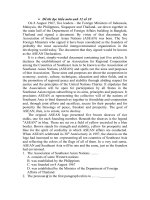- Trang chủ >>
- Đề thi >>
- Đề thi lớp 12
Đề thi đọc hiểu môn anh 12 số 9
Bạn đang xem bản rút gọn của tài liệu. Xem và tải ngay bản đầy đủ của tài liệu tại đây (80.14 KB, 2 trang )
Đề thi đọc hiểu môn anh 12 số 9
Today, more and more women are actively participating in social
activities both in urban and rural areas. Specifically, they have shined
brightly in even many fields commonly regarded as the man's areas such
as business, scientific research and social management. In some areas,
women even show more overwhelming power than men. The image of
contemporary Vietnamese women with creativeness, dynamism, success
has become popular in Vietnam's society. The fact reveals that the gender
gap has been remarkably narrowed and women enjoy many more
opportunities to pursue their social careers and obtain success,
contributing to national socio-economic development. According to Ms,
Le Thi Quy, Director of the Gender/and Development Research Centre
under the University of Social Sciences and Humanities, Hanoi National
University, gender equity in Vietnam has reached a high level over the
past decade. The rate of Vietnamese women becoming National
Assembly members from the 9th term to the 11th term increased 8.7%,
bringing the proportion of Vietnamese women in authority to 27.3%, the
highest rate in Southeast Asia. There is no big gap in the level of literacy
and schooling between men and women. Women account for about 37%
of university and college graduates, 19.9% of doctoral degree holders and
6.7% of professors and associate professors.
The legitimate rights of women and children are ensured more than
ever before with more complete legal documents including laws,
conventions and national action plans, among which the laws on "gender
equity" mark a turning-point in the empowerment of women.
Mass media also highlights the continued success of women in every
field and honors their great importance in modern society, helping to do
away with outdated perceptions about traditional women's duties. Many
projects on reproductive health care, children protection, and family
income improvement jointly conducted by various mass organizations,
state agencies and non-governmental organizations have created
favorable conditions for women to become involved.
1. The text is about …….
A. the changes in the status of Vietnamese women
B. the Vietnamese women's liberation
C. the Vietnamese sex discrimination
D. the discrimination that Vietnamese women have to face
2. Which adjective is not used to describe Vietnamese women?
A. successful B. creative C. narrow D.
dynamic
3. According to the data in the text, ……
A. Vietnamese women do not take part in authority
B. the level of literacy and schooling between men and women in
Vietnam is the same
C. there are more women in authority in Vietnam than those in any
other countries in Southeast Asia.
D. there are no female professors in Vietnam
4. Vietnamese women …….
A. have few opportunities to develop their intellectual ability
B. have only shined brightly in doing housework
C. cannot do any scientific research
D. are ensured their rights with laws, conventions and national action
plans
5. Which is not mentioned in the text as a project to create condition for
Vietnamese women?
A. Traditional women's duties. B. Reproductive
health care.
C. Children protection. D. Family income
improvement.
KEY: 1. A 2. C 3. C 4. D 5. A









